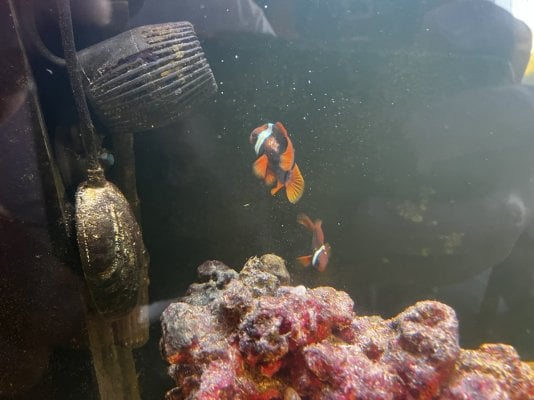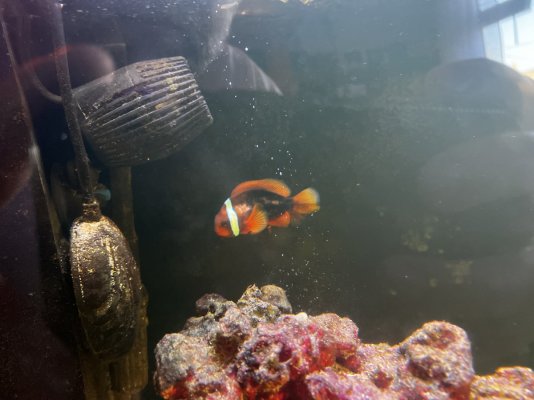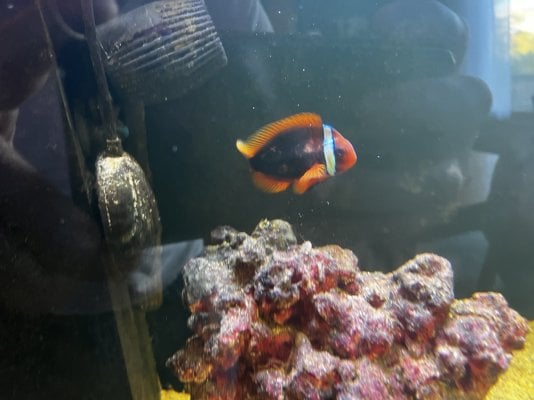Navigation
Install the app
How to install the app on iOS
Follow along with the video below to see how to install our site as a web app on your home screen.
Note: This feature may not be available in some browsers.
More options
You are using an out of date browser. It may not display this or other websites correctly.
You should upgrade or use an alternative browser.
You should upgrade or use an alternative browser.
Tomato Clownfish Too Thin and Has Weird Spots
vetteguy53081
Well known Member and monster tank lover
View Badges
Partner Member 2024
Excellence Award
Reef Tank 365
RGB
Article Contributor
Tampa Bay Reef Keepers
West Palm Beach Reefer
Hospitality Award
Ocala Reef Club Member
305 Reef Club
Wisco Reefers
Midwest Reefer
Fish Medic
MAC of SW Florida
Rock Pool Reef Keepers
R2R Secret Santa 2023
My Tank Thread
My Aquarium Showcase
This is likely bite marks which have led to body and flesh erosion. Have you noticed the clown has fought with other clown or other tankmate?
This type of wound is inviting to others and fish needs to be isolated while it heals, and I suggest treatment in QT with both Seachem Neoplex and Seachem metroplex added to foods at .5 gm weight which is a VERY TINY amount for 7-10 days. Assure during treatment to provide GOOD water quality which will help healing process and add aeration with air stone
Welcome to Reef2Reef!
It looks like you’ve had this fish for awhile? Has it been looking gradually thinner over a month or two? If so, I’d say this is Mycobacterium, fish tuberculosis. It affects long term captive fish. Sorry, but it isn’t treatable.
Jay
Thank you. Yes, I’ve had her for years. I’m not seeing a lot of good information online about what to do about your tank in general when one fish comes down with it. One source suggests that once one fish has it, you assume that all of the fish in your tank are infected and that you have to keep the system closed going forward so as to not introduce any new livestock. At that point, all you can do is wait until all of your fish pass away before starting over from scratch by disinfecting everything and throwing out any items that have porous surfaces, like love rocks. Is that right?Welcome to Reef2Reef!
It looks like you’ve had this fish for awhile? Has it been looking gradually thinner over a month or two? If so, I’d say this is Mycobacterium, fish tuberculosis. It affects long term captive fish. Sorry, but it isn’t treatable.
Jay
Thank you. Yes, I’ve had her for years. I’m not seeing a lot of good information online about what to do about your tank in general when one fish comes down with it. One source suggests that once one fish has it, you assume that all of the fish in your tank are infected and that you have to keep the system closed going forward so as to not introduce any new livestock. At that point, all you can do is wait until all of your fish pass away before starting over from scratch by disinfecting everything and throwing out any items that have porous surfaces, like love rocks. Is that right?
No, that's not correct. Mycobacterium is ubiquitous - it can be isolated from virtually every aquarium. It is found in tap water and frozen fish foods. It is just old fish and a few delicate species that come down with acute infections when exposed. Here is an excerpt from my fish disease book:
Mycobacterium infection (AKA "Fish Tuberculosis") is a common, yet often misdiagnosed bacterial disease of freshwater and marine fish. It has zoonotic potential as it can infect humans through cuts in the skin.
Symptoms are varied and non-specific, and can include; darkened coloration, emaciation, fin erosion, skin ulcers, and granulomas on the internal organs (which will stain for gram positive, acid-fast bacteria). In most cases, the disease is chronic and slow-acting, with most fish succumbing due to "old age". However, in some species, held under crowded conditions, acute Mycobacterium infections have been seen, where a high percentage of the population will die, even at a young age. This has been noted in cichlids, pupfish, pirate perch and zebra danios.
Many treatments for Mycobacterium infections in fish have been proposed, but none work well. Antibiotics that have been used include; erythromycin, kanamycin, and rifampicin. It is probable that any drug used would need to be dosed orally, especially if freshwater fish are being treated. Control is the best course of action; maintain optimal water quality, avoid overcrowding, and remove any dead fish promptly.
Atypical Mycobacterium, M. chelonae, M. fortuitum, M. marinum are very common in the environment, and therefore are found in aquariums. They are difficult to culture, but can be isolated from virtually every aquarium if you sample properly. They are commonly found in frozen seafood items, so the chance of them being introduced into aquariums is consistently high.
Sterilization of infected tank decorations and equipment is difficult, and not strongly advised since these bacteria are already in the environment, but > 200 ppm sodium hypochlorite for > 1 hour has been shown to be effective (Noga 2010).
Jay
Thank you so much. This is extremely helpful.No, that's not correct. Mycobacterium is ubiquitous - it can be isolated from virtually every aquarium. It is found in tap water and frozen fish foods. It is just old fish and a few delicate species that come down with acute infections when exposed. Here is an excerpt from my fish disease book:
Mycobacterium infection (AKA "Fish Tuberculosis") is a common, yet often misdiagnosed bacterial disease of freshwater and marine fish. It has zoonotic potential as it can infect humans through cuts in the skin.
Symptoms are varied and non-specific, and can include; darkened coloration, emaciation, fin erosion, skin ulcers, and granulomas on the internal organs (which will stain for gram positive, acid-fast bacteria). In most cases, the disease is chronic and slow-acting, with most fish succumbing due to "old age". However, in some species, held under crowded conditions, acute Mycobacterium infections have been seen, where a high percentage of the population will die, even at a young age. This has been noted in cichlids, pupfish, pirate perch and zebra danios.
Many treatments for Mycobacterium infections in fish have been proposed, but none work well. Antibiotics that have been used include; erythromycin, kanamycin, and rifampicin. It is probable that any drug used would need to be dosed orally, especially if freshwater fish are being treated. Control is the best course of action; maintain optimal water quality, avoid overcrowding, and remove any dead fish promptly.
Atypical Mycobacterium, M. chelonae, M. fortuitum, M. marinum are very common in the environment, and therefore are found in aquariums. They are difficult to culture, but can be isolated from virtually every aquarium if you sample properly. They are commonly found in frozen seafood items, so the chance of them being introduced into aquariums is consistently high.
Sterilization of infected tank decorations and equipment is difficult, and not strongly advised since these bacteria are already in the environment, but > 200 ppm sodium hypochlorite for > 1 hour has been shown to be effective (Noga 2010).
Jay
Similar threads
- Question
- Replies
- 5
- Views
- 217
- Replies
- 52
- Views
- 931
- Replies
- 11
- Views
- 189
- Replies
- 3
- Views
- 245
New Posts
-
NEW Euphyllia WYSIWYG Frags & Colonies 30% off--VIDEO
- Latest: PacificEastAquaculture
-
-
-
-

















